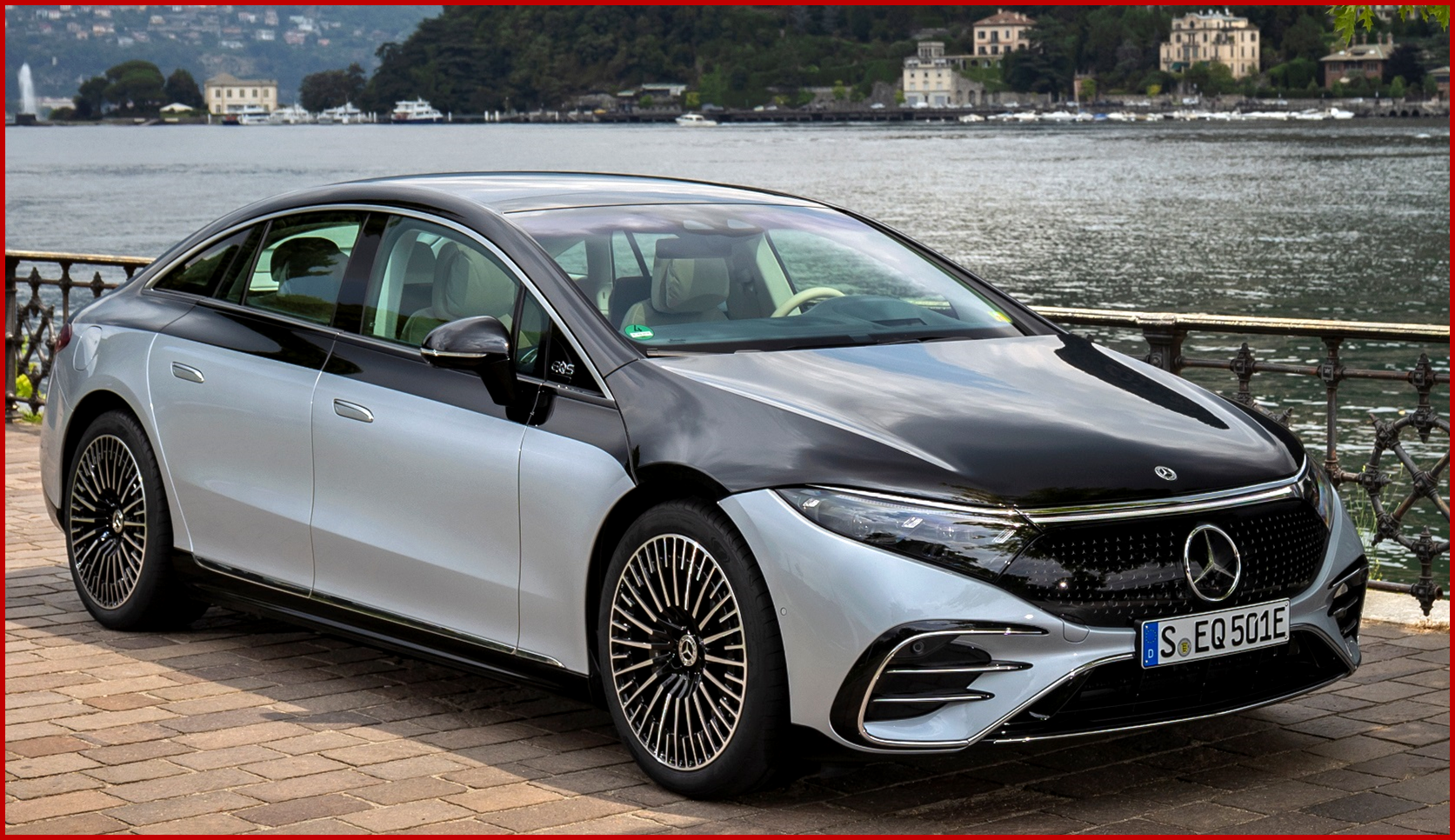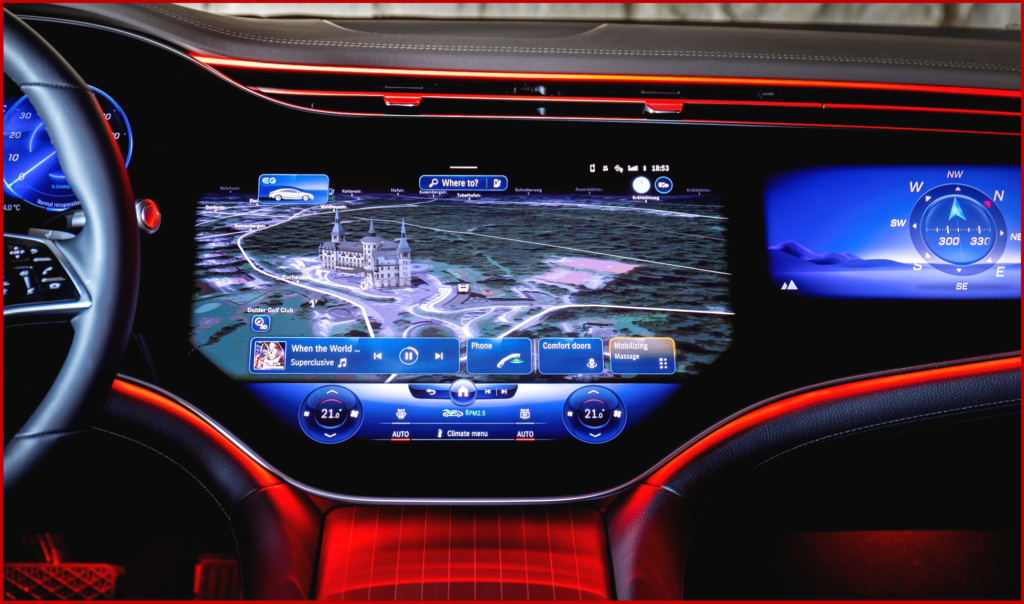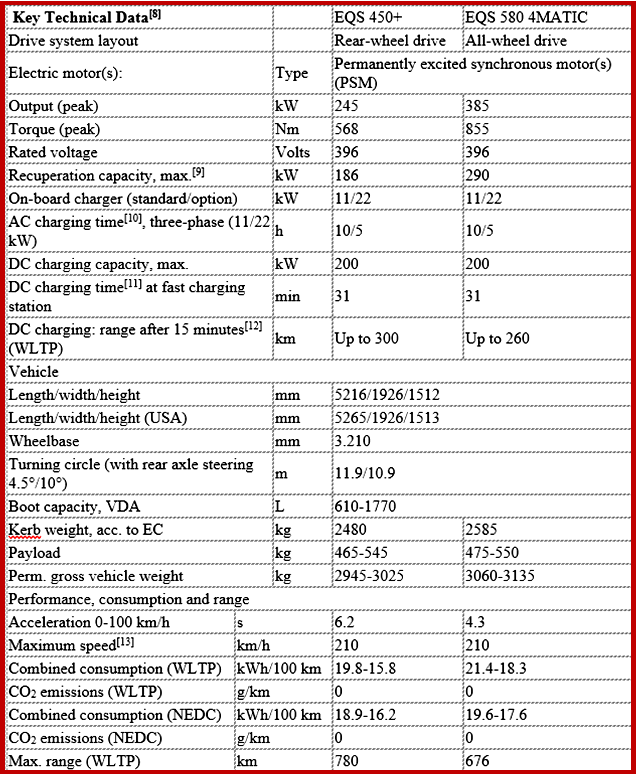 EQS is the first all-electric luxury sedan from Mercedes-EQ. With it, Mercedes is attempting to defend its competitiveness in expensive luxury vehicles, which is under attack by Tesla, Lexus, BMW and Porsche and Maybach, among others. EQS is also the first model – 2022 MY – to be based on the modular architecture for luxury and executive-class (Euro-speak for company cars) electric vehicles.
EQS is the first all-electric luxury sedan from Mercedes-EQ. With it, Mercedes is attempting to defend its competitiveness in expensive luxury vehicles, which is under attack by Tesla, Lexus, BMW and Porsche and Maybach, among others. EQS is also the first model – 2022 MY – to be based on the modular architecture for luxury and executive-class (Euro-speak for company cars) electric vehicles.
By 2030, the subsidiary of Daimler now – belatedly? – wants more than half the cars it sells to have electric drive systems – this includes all-electric vehicles and plug-in hybrids, areas it has been slow to embrace. The new EQS is claimed to be designed to be sustainable. “The vehicles are produced in a carbon-neutral manner, and resource-saving materials such as carpets made from recycled yarn are used. This is because Mercedes-Benz considers the entire value chain, from development and the supplier network to its own production. Mercedes-Benz AG has had its climate protection targets confirmed by the Science Based Targets Initiative (SBTI),” it says.

Inside the EQS 580 4MATIC is the MBUX Hyperscreen fitted as standard. This large, curved screen unit sweeps almost from A-pillar to A-pillar. Three screens sit under a cover glass and appear to merge into one. The 12.3-inch OLED display for the front passenger gives him or her their own display and control area. The entertainment functions are only available there while the car is being driven in accordance with the country-specific legal regulations. Mercedes-EQ relies on an intelligent, camera-based locking logic: if the camera detects that the driver is looking at the front passenger display, it is automatically dimmed.
The first EQS models to appear are the EQS 450+ rated at 245 kW (NEDC combined electrical consumption: 18.9-16.2 kWh/100 km; CO2 emissions: 0 g/km)and the EQS 580 4MATIC rated at 385 kW (NEDC combined electrical consumption: 19.6-17.6 kWh/100 km; CO2 emissions: 0 g/km). Fuel consumption per WLTP: EQS 450+ combined electrical consumption 19.8-15.8 kWh/100 km, CO2 emissions 0 g/km; EQS 580 4MATIC combined electrical consumption 21.4-18.3 kWh/100 km, CO2 emissions 0 g/km. (AutoInformed WLTP How Does It Work? Will it Work?; Subsidized Mercedes-Benz Compact EQA EV Available to Order; New Mercedes-Benz Strategy Aimed to Help Higher Profits; EU Gets Tougher on Climate Change – Wants All EVs by 2035; Mercedes-Benz – New Platforms Electric Only From 2025)
Aerodynamic specialists with the designers were able to achieve a new Cd benchmark[1] of 0.20. This makes the EQS the most aerodynamic production car in the world says MB. “The operating range particularly benefits from this. It is also among the best in terms of quiet running. The very low wind noise level contributes significantly to this.”
Recuperation is good: of the maximum deceleration in the DAuto recuperation program of 5 m/s², up to 3 m/s² is achieved by recuperation (2 m/s² by the service brakes). This allows deceleration to a standstill without using the brake pedal, while at the same time the range benefits from this recuperation strategy and the high recuperation power (up to 290 kW). Deceleration is also applied to detected vehicles ahead until they come to a standstill, for example at traffic lights. Driver reactions to extreme braking and the transitions remain to be seen or felt.
Intelligent recuperation is situation-optimized with the aid of ECO Assist and acts with anticipation, considering traffic conditions or topography, among other things. The driver can additionally set three recuperation levels and the gliding function with the shift paddles on the steering wheel.
With ranges up to 780 kilometers (WLTP) and an output of up to 385 kW, EQS is competitive S-Class segment. A performance version with up to 560 kW is planned. All EQS models have an electric powertrain (eATS) at the rear axle, while the versions with 4MATIC also have an eATS at the front axle.
 The EQS also marks the launch of a new generation of batteries with higher energy density. The battery management software, developed in-house, allows updates over the air (OTA). In this way, the energy management system remains up to date throughout the life cycle. In terms of the cell chemistry, the cobalt content of the cathodes has been reduced to 10%.
The EQS also marks the launch of a new generation of batteries with higher energy density. The battery management software, developed in-house, allows updates over the air (OTA). In this way, the energy management system remains up to date throughout the life cycle. In terms of the cell chemistry, the cobalt content of the cathodes has been reduced to 10%.
The EQS can be charged with up to 200 kW at fast charging stations with direct current. Power for another 300 kilometers (WLTP) is possible in 15 minutes[2]. At home or at public charging stations, the EQS can be charged with up to 22 kW with AC using the on-board charger. In Japan, bi-directional charging with the EQS will also be possible, i.e. charging in both directions. In addition, there are various intelligent charging programs that can be activated automatically depending on the location, and functions such as battery-saving charging.
By means of certificates of origin, Mercedes-Benz guarantees that energy from renewable energy sources is fed into the grid for charging current sourced via Mercedes me Charge. This so-called green charging has been an integral part of Mercedes me Charge since 2021. But Mercedes me Charge can do even more at a charging station[3] – open the flap, plug in and the current starts flowing from Plug & Charge. Other technical tidbits include the densest network of charging points, with more than 500,000 of them in 31 countries, including more than 200,000 in Europe. With IONITY Unlimited, all European Mercedes me Charge customers can use the fast-charging network free of charge for one year.
Navigation with cheap celebrex Electric Intelligence plans the fastest and most convenient route, including charging stops, based on numerous factors and reacts dynamically to traffic jams or a change in driving style. A new EQS twist is a visualization in the MBUX (Mercedes-Benz User Experience) infotainment system showing whether the available battery capacity is sufficient to return to the starting point without charging. Charging stations along the route that have been added manually are given preference in the route calculation. Proposed charging stations can be excluded. The estimated charging costs per charging stop are calculated.
Although the EQS is a close relative of the new S-Class, it is as noted built on an all-electric architecture. This made a Purpose Design possible: with its one-bow lines and cab-forward design with fastback, the EQS is clearly distinguishable from vehicles with combustion engines even at first glance. The design philosophy of Sensual Purity, combined with Progressive Luxury, is reflected in sculpted surfaces, reduced joints and seamless transitions.
The front is combined into a ‘Black Panel’ unit. Headlights connected by a light band and the deep black radiator grille (Black Panel) form the face. The exclusive look of the Black Panel radiator grille with central Mercedes star can be enhanced – as an optional extra, they are also available with a three-dimensional star pattern. This so-called Mercedes-Benz pattern is available in conjunction with AMG Line exterior or Electric Art exterior. The design picks up on the original star of the Daimler-Motorengesellschaft, which was registered as a trademark in 1911.
The EQS is the first Mercedes to offer the option of activating completely new vehicle functions via over-the-air updates (OTA) in some functional areas. Available from launch: two special driving programs for young drivers and service staff, some little games and the demo program “The Best or Nothing.” This means that after the purchase and the initial new-car configuration, some of the features of the EQS can be adapted according to personal preferences. For vehicles produced from the start of 2022 it will also be possible to unlock the rear axle steering with the larger steering angle of 10 degrees. In addition to the classic purchase of individual functions, subscriptions, temporary activations and free test phases are also planned.
With Energizing Air Control Plus, Mercedes-Benz is taking a comprehensive approach to air quality in the EQS. The system is based on filtration, sensors, a display concept and air conditioning. The HEPA (High Efficiency Particulate Air) filter has a high filtration level that enables it to trap fine particles, micro-particles, pollen and other substances that enter with the outside air. Sulphur dioxide, nitrogen oxides and odors are also reduced with activated charcoal coating. The HEPA filter has the “OFI CERT” ZG 250-1 certification in the area of viruses and bacteria. Using pre-entry climate control, it is also possible to clean the interior air before getting into the vehicle. The particulate levels outside and inside the vehicle are also displayed in MBUX. They can be viewed in detail in the dedicated Air Quality menu. If the quality of the outside air is low, the system can also recommend closing the side windows or the sliding sunroof.
As an option, the EQS has automatic comfort doors[4] at the front and rear. When the driver approaches the car, first of all the door handles extend. As he or she approaches further, the driver’s door opens automatically. Using MBUX, the driver is also able to open the rear doors, for example, to let in children at school. As an intelligent vehicle, the EQS has up to 350 sensors, depending on the equipment. These record distances, speeds and accelerations, lighting conditions, precipitation and temperatures, seat occupancy as well as the driver’s blink of an eye or the passengers’ speech. This information is processed by control units that, controlled by algorithms, make decisions quickly. So they are the brain, so to speak. The new EQS can expand its capabilities based on new experiences, because it is capable of learning because of artificial intelligence (AI).
Inevitable Mercedes-Benz Footnotes
- [1] EQS 450+ with 19-inch AMG wheel/tire combination and AMG Line exterior (available in the EU from the end of 2021) in the SPORT drive program
- [2] Charging speed at DC fast charging stations with 500 amps
- [3] This convenient authentication method will initially be available at the IONITY fast charging stations throughout Europe.
- [4] Follow aftermarket launch
- [5] Due to road traffic regulations, the availability and functions of these new assistance functions may be restricted in certain markets
- [6] The legally permissible secondary activities of the driver depend on the relevant national traffic regulations.
- [7] Optional in the EQS 450+
- [8] The electrical consumption (and information based thereon) has been determined on the basis of Commission Regulation (EC) 692/2008 according to NEDC and Commission Regulation (EU) 2017/1151 according to WLTP
- [9] This value refers to the electrical power fed into the electric battery due to recuperation. Deviations are possible
- [10] The charging times are for a 10-100% full charge at a wallbox or public charging station (AC connection with at least 11/22 kW, 16/32 A per phase)
- [11] The charging times are for a 10-80% charge at a DC fast charging station of category “K” or “L” pursuant to EN17186 with 500 A charging current
- [12] At DC fast charging stations with 500 amps based on WLTP range
- [13] Electronically limited



Pingback: Automated Driving – Mercedes to Work with Luminar on Lidar | AutoInformed